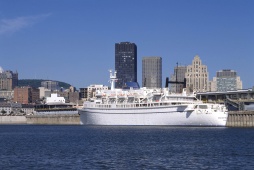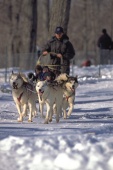
|
|||||||||||||||||

|
|||||||||||||||||
Québec, Canada
|

|
||||||||||||||||
English and French culture is somehow mixed and results in an unique blend. It's a friendly and romantic place where couples kiss on the street and strangers talk to each other. The Montréal Museum of Fine Arts and the Notre Dame Basilica are some of the must-see if you visit Montréal. Québec City shouldn't be missed out, if you visit the province. It is the heart of French Canada, with a rich history, culture and beauty. Its European appearance and atmosphere and the charm of an old-world city make a visit to an unique experience nowhere else found in North America. The entire old section of town has been designated a UNESCO World Heritage Site. Don't miss the historic battlements on the Plains of Abraham, which is one of the most important historic places in French and British history. Québec in Figures The country's largest province covers an area of 1,540,680 sq. km and is in many ways a country for its own. It is twice the size of Texas and seven times the size of the United Kingdom. It stretches approx. 2,000 km from north to south, and 1,500 km from east to west. It extends from the fertile St. Lawrence Lowlands bordering four US states (New York, Vermont, New Hampshire, Maine), to the vast expanse of Baffin Island and the northern boreal seas. Québec borders Ontario on the west and New Brunswick on the east. 7,241,400 people call Québec their home, which is about 24 per cent of the Canadian population. Québec's largest city is Montréal with 3,428,300 habitants followed by Québec City (687,200). The province's capital is Québec City. The province is home of a million lakes and rivers, comprising a fresh water network of 180,000 km2 . The highest mountain is Mont D'Iberville (1,622 m/5,320 feet) in the Torngat chain bordering Labrador. Arrival The most common way to Québec is via Montréal by plane. Flights from Europe usually go non-stop. Flights are offered by Air Canada and Lufthansa You should compare prices as there are many specials you can benefit from. Nearly 50 airlines serve the international airports in Montréal (Dorval and Mirabel), Québec City and Ottawa. Travelling within Québec VIA Rail offers a Canrailpass, valid for one month, entitling holders to 12 days of train travel across Canada. For more information visit the website at http://www.viarail.ca/ From May to October, the Rout-Pass is another option, which entitles holders to unlimited bus travel for 15 consecutive days in Québec and Ontario. For more information on the Rout-Pass card, call (514) 842-2281 in Montréal, or (418) 525-3000 in Québec City. We recommend a rental car or RV as roads are usually in good conditions. For those of you, who intend to discover the more remote areas of the province should consider renting a 4-wheel drive vehicle as gravel roads are fairly common. This applies also to those individuals who consider exploring the wilderness. However you should make up your mind before signing your rental contract as many vehicles may not be used on unpaved roads. This is especially important for RV renters. The speed limit on autoroutes is 100 km/h (60 mph), and drivers and all passengers must wear seat belts. The possession or use of a radar detector is prohibited, whether it is connected or not. Police officers may confiscate such devices and fine their owners from $500 to $1000 if they find one in a vehicle. Turning right on a red light is prohibited in Québec. Failure to comply could result in a $100- to $200-fine. For the more adventurous traveller a bus ride with Greyhound might be just what you are looking for. The network is broad and prices are reasonable. If you exactly know, where to go you can also take a domestic flight. Most towns have an airport with daily service. Means of payment Besides the most common credit cards (Visa, Master Card and American Express) you might consider carrying some Traveller's Cheques in Canadian currency and small denominations. Those are generally accepted like cash and have the advantage of being insured. However you should always carry some cash, especially if you intend to push forward to more rural areas. Here cash is the only thing that counts as most of the small shops do not have the equipment to accept credit cards. You should not bring German Marks or American Dollar in order to pay your bills. Prices All prices are generally subject to applicable taxes, which might be uncommon for European travellers. Taxes are added when you pay. Usually you have to pay 7 per cent GST (Goods and Service Tax) and 7.5 per cent QST (Quebec Sales Tax), which applies to the selling price including the GST. However some merchandise is tax exempt. Waiters in a restaurant generally require a tip, which is added to the bill's total as they generally receive only minimum wage. It is up to you, how much you leave, but 10-15 per cent is fairly common. Usually you leave the tip on the table as you go. Tip is also given to cabbies, hairdressers, barbers, hotel attendants and bellhops. We recommend saving all receipts, as tourists who have their place of residence outside of Canada might be eligible for tax refund. However, this only applies for amounts over CAN $50,00 per receipt (except accommodation receipt where no minimum amount applies) and a minimum of CAN $200,00 in total. Not eligible for tax refund are bills paid for gas or transportation. In any case it might be worthwhile to save receipts for accommodations or larger purchases that are exported. The application for tax refund can be found at the website address shown below. You can file your application up to six months after you have left the country and has to be in writing. A refund cheque will than be mailed to your home address. If you came by plane you are required to send your bording pass with your application. Receipts for goods have to be validated by Canada Customs as you leave Canada. For further information visit Visitor Tax Refund. Opening Hours Most stores are open from 9:30 a.m. to 9:00 p.m. Monday to Friday and from 9:00 a.m. to 5:00 p.m. Saturday, and noon to 5:00 p.m. Sunday. Some may be closed on Sunday or after 6:00 p.m. Monday to Wednesday. Banks are generally open from 10 a.m. to 4 p.m., Monday to Friday. The post office generally closes at 5 p.m. Emergency In an emergency (doctor, police, fire department), dial "911" within the Montréal and Québec urban communities and "0" anywhere else in Québec. National Parks and Provincial Parks
World Heritage Sites Québec has following World Heritage Sites: For further information on Québec's World Heritage Sites, please visit our Canada Vacation Planner. History Indians and Inuit who arrived from Asia many thousand years ago were the first inhabitants of an area which is today known as Québec. Whale and cod fishing brought the first Europeans to Québec's St. Lawrence Gulf. In 1534 French explorer Jacques Cartier landed in the Gaspé for François I, the King of France. Cartier claimed the entire territory for France. In 1608, Samuel de Champlain also of France founded a settlement at Québec City and recorded the word 'Kebec' for the first time. There were occasional disputes with the English through the century, which ended in the French and English War. In 1759 the British attacked Québec City and defeated the French. . This Battle of the Plains of Abraham, in which both generals lost their lives, altered the destiny of New France. Four years later under the Treaty of Paris France transferred the power and territory to England. A flood of new colonists from England, Ireland and Scotland were to arrive. The Constitutional Act -- or Canada Act -- was proclaimed in 1791. It divided the old province of Québec into Upper Canada (today's Ontario) and Lower Canada (today's Québec). Québec's earliest commerce was based on fur trading. The early and middle portions of the 1900s saw Québec change from a rural, agricultural society to an urban, industrialized one. The power and authority of the Catholic Church was strong, as about 90 per cent of the population is Roman Catholic. The 1960s brought the "Quiet Revolution" were all aspects of French society were scrutinized and overhauled. Québec became more and more independent - nationally and internationally. The influence of the Catholic Church declined sharply. The Canadian Federal Government was forced to seek new ways to ensure a long-term relationship between Québec and the rest of Canada. A national bilingualism policy was introduced. In 1976 a new era began, when the Parti Québécois was voted into power. In 1980, in a popular referendum, Québec voters rejected the proposition of sovereignty-association with the federal government of Canada. In October, 1995 a second referendum on Québec independence was also defeated by a narrow margin. |
|||||||||||||||||
More Travel Tips for Québec
|
|||||||||||||||||



